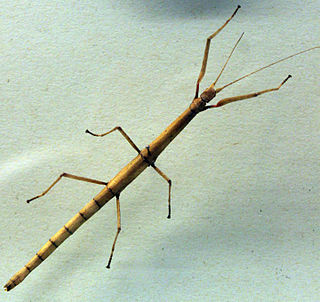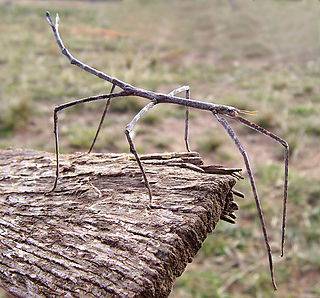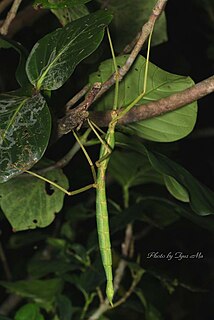
The Phasmatodea are an order of insects whose members are variously known as stick insects, stick-bugs, walking sticks, stick animals, or bug sticks. They are generally referred to as phasmatodeans, phasmids, or ghost insects. Phasmids in the family Phylliidae are called leaf insects, leaf-bugs, walking leaves, or bug leaves. The group's name is derived from the Ancient Greek φάσμα phasma, meaning an apparition or phantom, referring to their resemblance to vegetation while in fact being animals. Their natural camouflage makes them difficult for predators to detect; still, many species have one of several secondary lines of defense in the form of startle displays, spines or toxic secretions. Stick insects from the genera Phryganistria, Ctenomorpha, and Phobaeticus include the world's longest insects.

Siebenrockiella leytensis is a species of freshwater turtle endemic to the Philippines. It is classified as critically endangered. It is known as the Philippine forest turtle, the Philippine pond turtle, the Palawan turtle, or the Leyte pond turtle. Despite the latter common name, it does not occur in the island of Leyte but is instead native to the Palawan island group. It is locally known as bakoko in Cuyonon.

Phobaeticus serratipes is a species of stick insect that at one time was the longest known insect, with one female specimen recorded as being 555 mm long. This measurement includes the legs fully extended front and rear, and the actual length of the body alone is considerably shorter. This insect is endemic to Peninsular Malaysia, Singapore and Sumatra. It is a popular species among those who raise stick insects.

Carausius morosus is a species of Phasmatodea (phasmid) often kept as pets by schools and individuals. Culture stocks originate from a collection from Tamil Nadu, India. Like the majority of the Phasmatodea, C. morosus are nocturnal. Culture stocks are parthenogenetic females that can reproduce without mating. There are no reports of males, although in captivity, gynandromorphs are sometimes reared.

The Phasmatidae are a family of the stick insects. They belong to the superfamily Anareolatae of suborder Verophasmatodea.
The Visayan miniature babbler is a bird species in the family Cisticolidae. It was for a long time the only member of the genus Micromacronus, but the Mindanao miniature babbler, formerly included in M. leytensis as a subspecies, is now usually held to be a distinct species, M. sordidus.
Hermarchus is a genus of very large stick insects within the order Phasmatodea and the tribe of Stephanacridini. Known species occur in New Guinea, Fiji, Australia, Philippines and New Caledonia.
Phobaeticus chani or Chan's megastick, also known by its synonym Sadyattes chani, is a species of stick insect in the tribe Pharnaciini. It is one of the longest insects in the world and was once considered the record-holder. One specimen held in the Natural History Museum in London measures 567 mm (22.3 in). This measurement is, however, with the front legs fully extended. The body alone still measures an impressive 357 mm (14.1 in).

Ctenomorpha marginipennis, the margin-winged stick insect, is a species of stick insect endemic to southern Australia. The species was first described by George Robert Gray in 1833.
The Batak shrew is a species of shrew from the Philippines.
Eoprephasma is an extinct genus of stick insect in the susumaniid subfamily Susumaniinae known from a group of Eocene fossils found in North America. When first described there was a single named species, Eoprephasma hichensi.

The Heteropterygidae is a family of stick insects belonging to the suborder Euphasmatodea. Species can be found in Australasia, East and Southeast Asia. More than 130 valid species are descriebed.

Phasmotaenia lanyuhensis is a species of stick insect, order Phasmatodea. It is endemic to Taiwan. It is often included in the family Phasmatidae, although sometimes excluded from it when the family is strictly delimited. It derives its specific name from its type locality, Lanyuh Island, commonly known as Orchid Island.

The Obriminae are the most species-rich subfamily of the Phasmatodea family Heteropterygidae native to Southeast Asia. It is divided into two tribe.

The genus Dares, which is mainly native to Borneo, combines relatively small and mostly dark-colored Phasmatodea species.

Trachyaretaon is a genus of stick insects native to the Philippines.

Trachyaretaon carmelae is a species of stick insects. Even if there was no formal synonymisation, Trachyaretaon brueckneri is generally used as its synonym.
Trachyaretaon gatla is a species of Phasmatodea native to the Philippine island Palawan.
Nesiophasma giganteum is a recently described species of stick insect, order Phasmatodea. It is endemic to Peleng. Adult females are large, typically measuring 250–300mm in body length. Both sexes are wingless.











